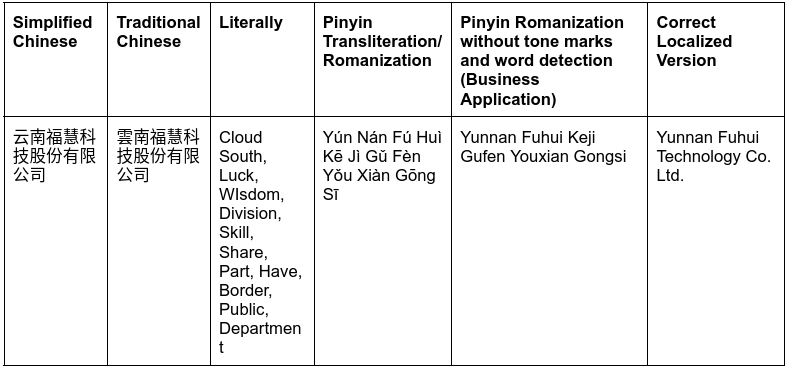Using Chinese Localization for Global Business Success
Chinese localization for the booming market in the Middle Kingdom holds ample business opportunities considering that there are over 1.4 billion Chinese native speakers across the world.
Localization goes beyond a simple translation, it also entails cultural and political sensitivity, technical specialties, and more.
QUANTO Solutions reveals how Chinese localization takes your business success to the next level globally and how to avoid pitfalls.
The Potential of the Chinese Market
The Chinese e-commerce market is the largest in the world with astronomical growth rates. With Chinese retail e commerce sales exceeding 2.7 billion USD in 2021, this segment is expected to reach 3.5 billion USD by 2024.
It is no wonder that Chinese and international businesses are eager to get a piece of the pie, especially in the face of the ongoing Covid-pandemic.
But is the Chinese market only restricted to Mainland China? The Standard Chinese language (Mandarin) is also the official language of Taiwan, Hong Kong, and Singapore, forming the Greater China area.
- Mainland China: 1.4 billion people
- Taiwan: 24 million people
- Hong Kong: 7.5 million people
- Singapore: 5.5 million people
As you can see, the target market for Chinese speakers is immense. So, how can your brand lift the potential of these Chinese speaking consumers? The keyword when entering or expanding in overseas markets is “localization”.
Internationalization vs. Localization
While the two terms are often used interchangeably, there’s actually a tangible difference.
Basically, internationalization (also abbreviated as “i18n”) is the process of preparing a product or service so that it can be used in several languages or regions without adaptations.
On the other hand, localization (also abbreviated as “L10n”) is the process of adapting internationalized products and services for a specific language or region (translation, transliteration) and adding local-specific aspects.
When designing software, spending more time on internationalization actually pays off and decreases the work to be done for localization. When data segments of code are separated from the program segments, translators can adjust the software later on easily without having to access the code.
This also applies when user interface components (dialog boxes, sounds, etc.) are separated from the program code.
What is Localization?
Generally speaking, localization is an integral part when taking your brand worldwide, where you tailor your products or services to the needs of the designated target audience in a specific country or region.

An interesting example to learn from is the American fast food restaurant chain Kentucky Fried Chicken, which had an infamous Chinese market entry 1987. The company’s slogan “finger-licking good” was incorrectly translated to “eat your fingers off”, causing a huge setback for KFC in China.
But KFC didn’t want to cut their losses just yet. Despite the brand’s focus on fried chicken, KFC expanded its menus in China with Chinese porridge, traditional Chinese breakfast breads, and a variety of rice-based dishes. This was just the right strategy.
While younger people were curious to try the new Western food, older people could still order the traditional dishes they knew, accepting KFC into Chinese culture. Today, KFC is still on the rise in China with more than 7,900 outlets in more than 1,600 cities.
As you can see, language plays an important role in this process and can be considered a subcategory of localization. In addition, localization considers cultural aspects and language-related issues like
- in which order to write names, addresses, dates, etc.
- the writing direction
- units of measurement
- technical specifications
Make sure to consider the following aspects in any localization process
- consider local and cultural practices, as well as language specifics
- create a localization schedule including resource planning and translation
- consider localization as early as possible, ideally already in the brand/product development phase
So, what does this mean for localization in China? Let’s take a look.
Specialties of Chinese Localization
Every market has its specific needs, regulations, and aspects.
- Chinese write from the largest unit to the smallest unit (e.g. year-month-day, country-province-city-street-number-name-business)
- Chinese is written primarily from left to right
- China uses the metric system for measurements
- The currency is RMB (¥) with commas as thousand separators
- China operates on a 220V voltage and uses type D electrical plugs
- International companies working with the Chinese market need to apply romanization to their master data to communicate, document, and do business correctly
- The name format is family name first and the given names second; the majority of Chinese family names only have one character, and there are only 81 compound surnames in the Mainland China; most given names have two characters and only rarely one character
- In the commercial and financial contexts, different characters are used for numbers (0-9) compared to everyday life
In terms of cultural aspects, you may want to consider the following
- Chinese consumers are picky; as there is an abundance of products and services available, small mistakes easily cause a shift to other brands
- Bright colors and playful appearances sell better in China (compared to sleek and minimalist designs in the West); keep in mind that colors have clear meanings associated that are different from the West
- QR codes are extremely popular; make sure to link to WeChat via QR code from your Chinese website
- Special and limited editions are very popular
Important: Things to specifically avoid mentioning in the Mainland China market
- “The Republic of China” as this is how Taiwan refers to itself, whereas China sees Taiwan as a province – same as Hong Kong and Macau
- Taiwan’s independence and anything related to Taiwan (e.g. holidays, maps)
- Communist bandits – a derogatory term for communists in China including the ruling party, the Communist Party of China (CPC)
Let’s take a closer look at Chinese romanization, transliteration, transcription, and translation.
Chinese Translation, Transliteration, Transcription, and Romanization
From a technical point of view, correct and central data management, for example in SAP Business Suite is essential to work and communicate correctly – both on a personal level and legally.
While there are more than 7,000 languages worldwide, Standard Chinese (Mandarin Chinese) is the most spoken language with 1.3 billion native speakers, followed by Spanish, English, Hindi, and Arabic.
When converting texts with different alphabets or scripts (Latin, Chinese Characters called Hanzi, Devanāgarī, Arabic script, etc.) into another script, transliteration, transcription, and romanization come into play. Keep in mind that these terms are often used interchangeably.
Transliteration and Transcription
Often used synonymously, transcription and transliteration refer to the conversion of words based on their pronunciation. This is done by using a defined phonetic spelling set. Transcription/transliteration allows you to pronounce words that are written in your own language, for example, Chinese characters that have been transcribed into Latin script or vice versa.
While transliteration/transcription doesn’t say anything about the meaning of a word, it helps readers to pronounce them by writing similar-sounding characters of the target language.
For Simplified Chinese, the official transliteration system is called Pinyin, allowing the conversion of Chinese characters into sounds of the Latin alphabet. For Traditional Chinese, the Bopomofo/Zhuyin system is used for transliteration.
So, even if someone doesn’t speak Mandarin Chinese, he or she could read and pronounce texts that are displayed in Pinyin. More importantly, transliteration is especially helpful in the digital business world, for example, to manage the master data of overseas partners. Keep in mind that in business, the Pinyin system is typically used without tone marks.
If your brand has a Chinese website, remember to also apply transliteration to the URL slugs in China. Chinese characters are displayed as encoded characters, which has negative impacts on local search engines and results in display errors. Instead, transliterate slugs with Chinese characters to Pinyin slugs.
Software Transliteration
In case you were wondering, if there was an easier way to go about the whole process of transliteration as part of localization, yes, there is! Specifically-designed software can help businesses to ease the process of transliteration.
QUANTO Solutions is in this field, providing you with consultation and implementation of the latest technical solutions for software-assisted transliteration and translation. Take a look at the QUANTO Transliteration Center here.
A subcategory of transcription/transliteration is romanization. Let’s take a look at this next.
Romanization
Romanization refers to the transliteration of a foreign language into Latin letters specifically. With the Latin script (romanized alphabet) being used in most languages, including English and Spanish, it is used for romanization in China.
For Chinese localization, the correct terminologies are as follows
- Simplified/Traditional Chinese → Latin script: Romanization, Transcription/Transliteration
- Latin script → Simplified/Traditional Chinese: Transcription/Transliteration
Names of individuals and companies, addresses, titles, positions, company departments, and legal entities are typically localized through romanization, often in combination with transliteration, transcription, and translation.
Let’s take a look at a few examples in order to get a better understanding of how romanization works in practice.
Examples of Chinese Localization
Let’s take a look at a few examples.
Example Names
Names of individuals and companies require a mix of transliteration and translation. This also applies to addresses.

Example Addresses
Writing addresses in Chinese requires starting with the largest entity and ending with the smallest. For example:
- Chinese: 中国, 北京市, 东城区, 交道口南大街, 78号
- Localized romanization with additional logic: China, Beijing, Dongcheng Area, Jiaodaokou South Street, Nr. 78
What’s noteworthy is that in Chinese, the descriptive particles (e.g. No., Floor, Building) are written after the actual number, floor, building, etc. while in Latin they are written before: 78号 vs. Nr. 78.
Also note that in the above example, the terms “China”, “Area”, “South Street” and “Number” have been translated, while “Beijing”, “Dongcheng”, and “Jiaodaokou” have been transliterated.
Example Business

A Chinese company name is typically composed of the city where it was founded, the name, the industry, and the type of company. The above example “云南福慧科技股份有限公司” is broken down into 云南 (Yunnan province, a transliteration), 福慧 (Fuhui, the name of the company as a transliteration), 科技 (technology, the industry, which is a translation), and 股份有限公司 (Co. Ltd., the company type, also a translation).
Another interesting example for an international brand name that was localized for the Chinese market is the German car brand “Volkswagen”, which means “people’s car” in English. The Chinese localization “大众汽车” was chosen as it describes the meaning perfectly, but also the second Chinese character looks similar to the Volkswagen logo with the “V” and “W” in it.
Challenges & Solutions
As you can perhaps imagine, the main challenge for Chinese localization is to know when to apply romanization or transcription/transliteration/translation or a combination of these.
Besides, the Latin script is rather limited with 26 characters whereas there are more than 50,000 characters in Traditional/Simplified Chinese (3,000 – 5,000 characters is required for everyday use). Moreover, there are many sounds in the Chinese language that cannot fully be replicated with the Latin alphabet.
Finally, there are no extensive free transliteration, transcription, and romanization online tools available. While there are a handful of romanization plugins/libraries based on Unicode’s ICU project, these require a range of manual adjustments, but are a good starting point for transliteration.
A highly customizable integrated online solution for the transliteration of master data in the form of an Application Programming Interface (API) that can be integrated into any environment, can take those worries off of your shoulders. Contact QUANTO Solutions for more information.
Simplified and Traditional Chinese
Using Simplified Chinese and Traditional Chinese correctly is an integral part of localization.
Chinese characters are the oldest writing systems that are still used today. One of the main differences between Traditional Chinese and Simplified Chinese is the number of strokes. Traditional Chinese has significantly more strokes compared to Simplified Chinese.
Mainland China and Singapore use Simplified Chinese characters to communicate, while Hong Kong and Taiwan use Traditional Chinese characters.
| Example | Traditional Chinese | Strokes | Simplified Chinese | Strokes |
| Telephone | 電話 | 13 + 13 = 26 | 电话 | 5 + 8 = 13 |
Overall, one can observe that there are more characters in Traditional Chinese, but there are also new characters being created. These are often invented by Chinese netizens and are extremely popular on social media. While these may not be official Chinese characters, they are still being used and need to be considered when localizing content.
Generally, all Chinese speakers can read Simplified Chinese, but only those who studied Traditional Chinese can decipher it. Whereas the older generation in mainland China also learned Traditional Chinese, today’s generation mostly can only read Simplified Chinese, except for university students.
Benefits of Chinese Localization
As you can see, Chinese localization requires a mix of transliteration and translation, extra logic like word detection and other local specifications (e.g. address format) to
- get financial scores for businesses
- check global business sanction lists and avoid high fines
- issue official documents (contracts, invoices, etc.)
- manage business partner master data (SAP, etc.)
- administer databases (marketing, etc.)
What may be interesting for you to know is that businesses in the Middle Kingdom can use the SAP systems SAP ERP ECC and SAP S/4HANA, which are available in Simplified Chinese and Traditional Chinese. If they work with international partners they will need to apply transcription/transliteration.
The Takeaway
Chinese localization through transliteration and translation is vital for businesses working with overseas partners to manage master data, work within the legal framework, assess potential partners based on their financial scores, check global sanction lists, and administer databases correctly.
QUANTO Solutions offers one-stop technical solutions for your business to enter or expand in overseas markets, including SAP translation, localization services and digital solutions to make this process easier for you.
The QUANTO Transliteration Center is centralized and provides easy script conversion, complies with local regulation, is integrated through a platform-independent API, and also provides solutions for non-developers.
Contact our team of IT specialists and security experts to discuss the best strategy for your business. Book your FREE consultation today!










